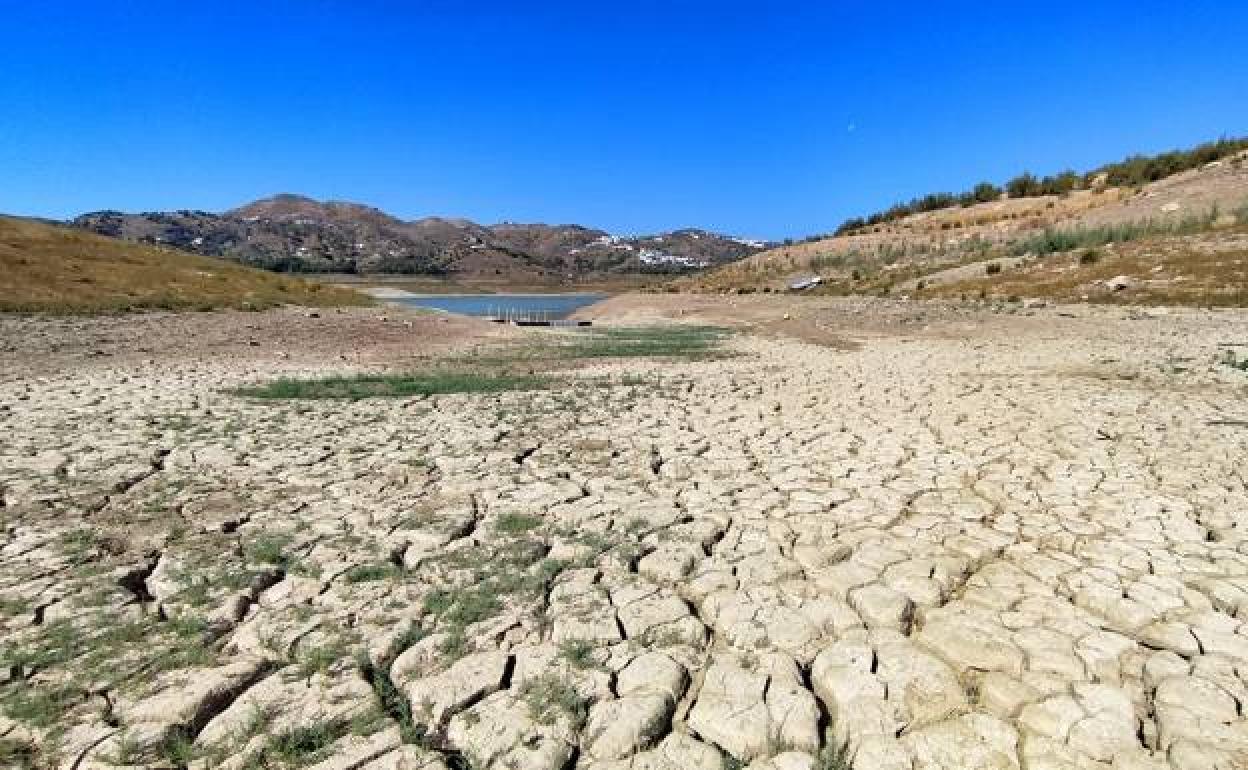La Viñuela is on the verge of being declared a 'dead reservoir'
The Axarquía reservoir, which supplies water to 180,000 inhabitants of 14 towns, is at just 10.72% of its capacity - the lowest level since 2008
Barring a last minute miracle in the form of heavy rains in the next few weeks, everything points to La Viñuela reservoir in the Axarquía heading for a repeat of the scenario of 31 October 2008, when it was left with only 15.2 cubic hectometres, at 9.2 per cent of its capacity. On Sunday 18 September it stood at 17.62 cubic hectometres or 10.72 per cent.
The reservoir, which supplies water to 180,000 inhabitants of 14 towns and supplies water for irrigation of the 6,200 hectares of the Guaro Plan, is on the verge of being declared a 'dead reservoir'. A designation that is normally used when a dam falls below 11 per cent of its capacity or when it is impossible to continue extracting water from it, because what is left at the bottom is only mud.
This scenario has not yet been reached, according to sources at the Territorial Delegation of Agriculture, who have denied that La Viñuela is, at the moment, a dead reservoir. However, the sources have not been able to specify at what level of reserves this terminology will be accepted. "Water continues to be extracted for human consumption, which is treated at the El Trapiche water treatment plant, and supplied to the irrigation communities that have not exhausted their allocation of 1,500 cubic metres per hectare per water year, until 30 September," they highlighted.
Wet period
Although there is no conclusive data, different sources consulted by SUR have pointed out that the registered population may have increased by around 20 per cent since the reservoir opened in 1989, while the irrigable surface area has increased by around 40 per cent in the last decade.
However, it is worth remembering that following that fateful date in October 2008, an intensely wet period began in the Axarquia, which lasted for at least three years. It rained to such an extent that the reservoir had to release water in May 2011. Previously it had only done so in 1998 and 2004.
It filled up again in November 2012, which was the last time the Junta de Andalucía technicians were forced to open the floodgates to relieve the water and prevent it from overflowing. Since that date, the reservoir has only gone down, standing, in the last decade, at an average of 47.5 per cent, with 78 cubic hectometres. However, the last few years have been particularly dry, especially since October 2021.
Irrigation quotas
Just 240 litres per square metre of rain have fallen in the reservoir, compared to 105 litres more the previous year. These figures explain why, twelve months ago, the reservoir still had 37.7 hectometres, at 23 per cent of its capacity. In recent weeks, the rate of consumption has dropped considerably after the end of the summer, from around 0.6 hectometres a week to 0.3. As such, if this trend continues, the Axarquía reservoir would equal its historic low at precisely the same time; the end of October.
The could see the Junta to cut the irrigation quota for the next water year to zero, putting the hitherto thriving subtropical sector at risk. Avocados are the most threatened crops, due to their higher water consumption. Mangoes, which are currently being harvested, are more resistant to the water deficit. However, they are smaller than in wetter years and this is leading to lower prices for the farmer.
The solutions involve the use of reclaimed water, which only covers less than half of the cultivated area in the Guaro Plan. Since last November, 5.2 cubic hectometres have been supplied to 2,700 hectares on the right bank of the Vélez river and pumping has already begun to bring another 1.8 hectometres for 520 hectares into Torrox.
In Algarrobo they are awaiting the repair of the treatment plant to provide around 0.8 cubic hectometres from November. The Rincón de la Victoria station has the capacity to provide about three cubic hectometres, but requires a seven-kilometre pipeline costing seven million euros.
As for the water supply, the Axarquía’s public water company, Axaragua, has once again called for an increase in the water supply from Malaga city’s reservoirs, which currently stands at 220-230 litres per second. However, following improvements to the reversible pumping station at La Rosaleda, this could now reach almost 400 litres per second, but the high demand in Malaga city and its suburbs prevents an increase in the quantity.
Councils asked to save 20%
The vice-president of Axaragua and mayor of Iznate, Gregorio Campos, has also called for the transfer of water from the Chíllar river in Nerja to Torrox, Mezquitilla and Lagos, which could provide another 150 to 200 litres per second, to be activated "once and for all".
This project has been pending since 2018. Sources from the Delegation of Agriculture have explained that it is "in the final phase, pending electricity connection by Endesa, so it is imminent". The Mancomunidad, which oversees the 31 town halls across the Axarquía has also called for councils to save 20 per cent of their water consumption.
With regard to the drought management committee, which will have to analyse the situation and will probably cut the allocation for farmers to zero from 1 October, the sources consulted by this newspaper pointed out that "the deadline will be rushed and it will be convened before the end of September".

